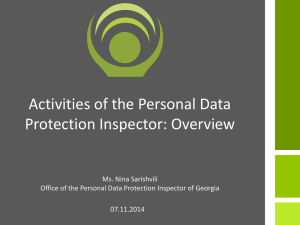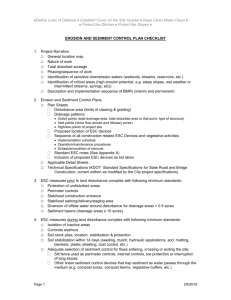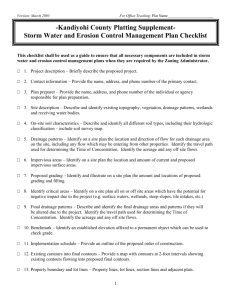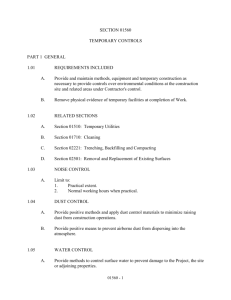Land Development Review Plan Notes Checklist 2014
advertisement
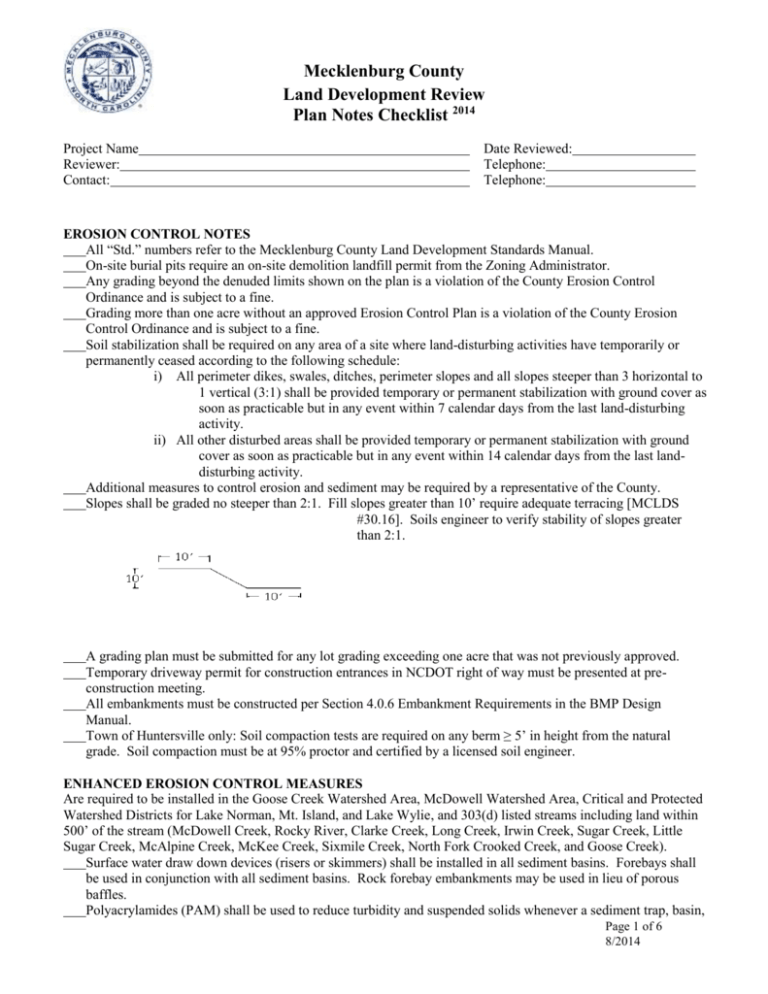
Mecklenburg County Land Development Review Plan Notes Checklist 2014 Project Name Reviewer: Contact: Date Reviewed: Telephone: Telephone: EROSION CONTROL NOTES All “Std.” numbers refer to the Mecklenburg County Land Development Standards Manual. On-site burial pits require an on-site demolition landfill permit from the Zoning Administrator. Any grading beyond the denuded limits shown on the plan is a violation of the County Erosion Control Ordinance and is subject to a fine. Grading more than one acre without an approved Erosion Control Plan is a violation of the County Erosion Control Ordinance and is subject to a fine. Soil stabilization shall be required on any area of a site where land-disturbing activities have temporarily or permanently ceased according to the following schedule: i) All perimeter dikes, swales, ditches, perimeter slopes and all slopes steeper than 3 horizontal to 1 vertical (3:1) shall be provided temporary or permanent stabilization with ground cover as soon as practicable but in any event within 7 calendar days from the last land-disturbing activity. ii) All other disturbed areas shall be provided temporary or permanent stabilization with ground cover as soon as practicable but in any event within 14 calendar days from the last landdisturbing activity. Additional measures to control erosion and sediment may be required by a representative of the County. Slopes shall be graded no steeper than 2:1. Fill slopes greater than 10’ require adequate terracing [MCLDS #30.16]. Soils engineer to verify stability of slopes greater than 2:1. A grading plan must be submitted for any lot grading exceeding one acre that was not previously approved. Temporary driveway permit for construction entrances in NCDOT right of way must be presented at preconstruction meeting. All embankments must be constructed per Section 4.0.6 Embankment Requirements in the BMP Design Manual. Town of Huntersville only: Soil compaction tests are required on any berm ≥ 5’ in height from the natural grade. Soil compaction must be at 95% proctor and certified by a licensed soil engineer. ENHANCED EROSION CONTROL MEASURES Are required to be installed in the Goose Creek Watershed Area, McDowell Watershed Area, Critical and Protected Watershed Districts for Lake Norman, Mt. Island, and Lake Wylie, and 303(d) listed streams including land within 500’ of the stream (McDowell Creek, Rocky River, Clarke Creek, Long Creek, Irwin Creek, Sugar Creek, Little Sugar Creek, McAlpine Creek, McKee Creek, Sixmile Creek, North Fork Crooked Creek, and Goose Creek). Surface water draw down devices (risers or skimmers) shall be installed in all sediment basins. Forebays shall be used in conjunction with all sediment basins. Rock forebay embankments may be used in lieu of porous baffles. Polyacrylamides (PAM) shall be used to reduce turbidity and suspended solids whenever a sediment trap, basin, Page 1 of 6 8/2014 pit, hole, or building foundation is being pumped out to remove sediment laden water. PAM is not required when any of the above is being pumped to an approved sediment basin on site. This activity must be inspected and approved by the Mecklenburg County erosion control inspector. Double silt fence shall be used along wetlands, streams, lakes or other surface water bodies as well as adjacent to all S.W.I.M. or other Water Quality Buffers. High hazard silt fence with wire backing and washed stone will be installed as determined necessary by the County Engineer or field inspector. The amount of uncovered area at any one time shall be limited to no more than 20 acres, unless approved by the County Engineering. A 10-foot undisturbed buffer shall be provided around the outside edge of drainage features such as intermittent and perennial streams, ponds, and wetlands. Incidental drainage improvements or repairs will be permitted within the buffer as approved by county staff. Installation of temporary ground cover or seeding must be performed within five (5) working days or slope drains installed after fill slopes are brought up to height. Permanent terraces shall be installed on 2:1 or steeper slopes over 19 feet in height to reduce runoff velocity coming down the slopes. SWIM STREAM BUFFERS Required Plan Notation The streamside zone of the buffer must be left completely undisturbed. In the managed use zone, a limited number of trees can be removed provided that the tree density remaining is a minimum of 8 healthy trees of a minimum 6-inch caliper per 1,000 square feet. Removal of existing vegetation must be performed in such a manner as to prevent damage to the roots of remaining trees. Plans clearly indicate that NO fill material is to be brought into the buffer and that no structures are allowed within any of the buffer areas (except non-commercial out buildings not exceeding 150 square feet). Grading and other land-disturbing activities are allowed only in the upland zone; however, these activities must be performed in such a manner as to prevent damage to the roots of remaining trees. Grass or other suitable ground cover can be applied to the upland zone. The outside boundary of the buffer must be clearly marked with orange fabric fencing prior to any landdisturbing activities (grading, tree-cutting or stumping, etc.) at the site and this fencing must be called out on the plans. The outside boundary of the stream buffer must be permanently marked with an iron pin or other acceptable property corner marker at street crossings and this marker must be called out on the plans. Any activity in the buffer must also comply with the applicable Zoning Ordinance. Stream buffers must be surveyed and clearly marked in the field prior to the preconstruction meeting with the Water Quality staff. OTHER NOTES TO APPEAR ON PLAN Coordinate all curb and street grades in intersection with Inspector. All road improvements at are to be coordinated with the Town or County LUESA prior to construction. Developer will provide street name signs per MCLDS# 50.05 (9" signs only) Sight triangles shown are the minimum required. Direct vehicular access to from lots is prohibited. In rolling and hilly terrains, sweeping of the stone base and/or application of a tack coat may be required near intersections. These requirements will be established by the Inspector and based on field conditions. Approval of this plan is not an authorization to grade adjacent properties. When field conditions warrant off-site grading, permission must be obtained from the affected property owners. Handrails may be required by a representative of the County, if warranted by field conditions (MCLDS 50.04A,B). In order to ensure proper drainage, keep a minimum of 0.5% slope on the curb. Subsurface drainage facilities may be required in the street right-of-way if deemed necessary by the inspector. The purpose of the storm drainage easement (SDE) is to provide storm water conveyance. Buildings are not permitted in the easement area. Any other objects which impede storm water flow or system maintenance are Page 2 of 6 8/2014 also prohibited. (Add as note stating who is responsible for the easement) High-density polyethylene (HDPE) storm drainage pipe installed within existing or proposed public street rightof-way must: Be approved by public works representative from the town prior to getting plan approval. Be approved by the County's Inspector prior to any backfill being placed. Backfill material must be approved by the County Inspector prior to placement of the material within the public street right-of-way. If town public works agree to have the pipe installed there shall be an approved bedding detail and a third party inspector shall verify compaction and supply written evidence of compaction results. The developer shall maintain each stream, creek, or backwash channel in an unobstructed state and shall remove from the channel and banks of the stream all debris, logs, timber, junk and other accumulations. Any building within the 100+1 Building Restriction Floodline is subject to the restrictions of the ordinance in the governing jurisdiction. Any construction or use within the areas delineated as Community Encroachment (0.1’) Floodway Encroachment Area is subject to the restrictions imposed by the Floodway Regulations of the Northern Towns and Mecklenburg County. All openings (e.g., doors, windows, vents) in structures built on lot #'s should be located a minimum of one foot above the adjacent finished ground surface (Applies to lots which may experience significant overland flow not considered in the 100+1 flood analysis.) Retaining walls > 4 ft (residential) or 5 ft (commercial) in height requires a permit from Code Enforcement prior to construction. The engineer of record for the retaining wall(s) must certify that the wall(s) is (are) constructed to specifications prior to issuance of C.O. Retaining walls involving a culvert or located within the influence of a road must be reviewed and approved by Land Development. Culverts must have headwalls or be collared. Construction of retaining wall(s) cannot begin until all necessary permits are acquired. "As-built" drawings and plans of the storm drainage system, including designed ditches, must be submitted prior to subdivision final inspection to the County Engineering Department in accordance with the Subdivision Ordinance. As-builts for all applicable detention structures and BMP measures are required. As-builts are to include latitude and longitude for center of measure, and inlets and outlets of all structures. Elevations are required for all measures as well as dimensions of all measures. Prior to installation, PE sealed shop drawings for underground detention systems and outlet restriction devices must be furnished to LUESA for approval. Prior to CO, surveyor sealed as-built drawings of underground detention systems must be provided. Non-standard items (i.e. pavers, irrigation systems, etc.) in the right-of-way require a Right-of-Way Encroachment Agreement with the Town/North Carolina Department of Transportation before installation. Plat approval shall be limited to 50 dwelling units within a residential subdivision until all turn-lanes, road widening, striping etc. has been completed and approved by the appropriate authority. Prior to plat recordation, Offsite R/W and/or construction easements are required to be obtained according to the guidelines of the "Offsite R/W Acquisition Process". These needed R/W and construction limits are clearly shown on the roadway improvement plan. The Developer shall contact the North Carolina Department of Transportation to identify any conflicts with traffic signalization equipment. Developer shall be responsible for all related relocation cost and/or any repair cost caused by the contractor/developer. For subdivision plans which only show grading of the roadway, the following note shall be added to the plans. Before any lots are denuded outside of the permitted area as shown on this approved set of plans, a revised plan must be submitted and approved by Mecklenburg County LUESA Land Development staff. Any lot development without a revision to the approved plan could result in immediate civil penalties being issued to both the developer and home builder. TRAFFIC CONTROL NOTES 1. Street space is at a minimum so no more space should be used for construction or maintenance work than is absolutely necessary. Through barricading and channelization, the remaining street space is to be used to carry the traffic around the work area in the best way possible under prevailing conditions. Page 3 of 6 8/2014 2. Traffic control devices shall be set up prior to the start of construction or maintenance operations, and shall be removed or relocated as the work is finished or work conditions change. The agency doing the work shall patrol the work site as required to ensure that all traffic control devices are in place and operating at all times. 3. All traffic control signs for the work area shall be reflectorized. The reflective materials used shall be equal to or better than Type III, VII, VIII, or IX retroreflective sheeting requirements in Section 633 of the Standard Specifications for Construction of Roads and Bridges on Federal Highway Projects (FP-03). 4. At night, adequate barricades with reflectorized material and lights are required to call attention to and to indicate the actual location of obstructions and hazards. 5. When not in use during work hours or construction inactivity, equipment shall be parked a minimum of 10’ away from the travel lane in such a manner as to not create a sight distance problem for motorists. 6. The minimum width for temporary travel lanes is 10’ (11’ for state maintained roads); however, a 12’ lane is advisable and should be provided whenever possible. 7. Whenever traffic must be routed across the centerline, the two directions of traffic must be physically separated. Traffic cones can be effectively used for this purpose during daylight hours; retroreflectorized drums must be used at night. 8. Traffic shall not be routed across centerline with cones or drums during non-working hours. Contractor must be on site or change pavement marking appropriately. 9. Generally, the peak flow of traffic occurs in Mecklenburg County between the hours of 7-9 a.m. and 4-6 p.m., Monday through Friday. During these hours, construction activity that involves a lane closure will not be allowed on thoroughfare streets except in emergency situations or with approval from the Town Public Works and/or NCDOT. 10. The agency doing the work shall provide flaggers and/or Police control when required. Contractor may also be required to provide a uniformed officer to control traffic when working in and around a signalized intersection. 11. Every attempt shall be made to schedule and expedite the work to cause the least inconvenience to the traveling public. 12. In situations not covered in this design, the protection of the traveling public and the protection of the workers on site will dictate the measures to be taken consistent with the City of Charlotte Work Area Traffic Control Handbook (WATCH). 13. The contractor, utility company, or governmental agency involved in the work shall notify Mecklenburg County Land Development and/or NCDOT of the construction start date and any major work where the number of travel lanes are reduced from normal conditions or the street is required to be closed. Except in emergencies, the following notification is required: Construction start date – 5 working days in advance Closing 1 or more travel lanes during Peak Travel Times – 5 working days prior to the scheduled work Closing a street – 10 working days prior to the scheduled work. This lead-time is necessary for planning and notifying the public of expected changes in the normal traffic conditions. 14. The County Engineer or NCDOT or their representatives are authorized to stop any construction or maintenance activity which is not properly signed and barricaded as required by this standard, the WATCH, and/or the MUTCD until such requirements are met. 15. This design standard cannot be used for all roadway construction situations. It is intended only to be used as a guideline. Specific situations may require engineering judgment in the placement of traffic control devices because of limited vertical and/or horizontal sight distance. 16. When personnel and/or equipment are within 2’ of the edge of an open travel lane (5’ on state maintained roads), the contractor shall refer to the WATCH for proper lane closure. 17. Operational signs are generally mounted on portable supports. These are usually used for short-term operations to warn and guide traffic. Advanced warning signs (Construction Ahead) shall be mounted on stationary supports seven days prior to the beginning of construction of the roadway. 18. All drums shall be ballasted in such a manner that they will be stable under wind and vehicle action. Ballasting shall be done with sandbags or other yielding material situated in the base of the drums. 19. Construction work shall not be allowed on both sides of the road simultaneously within the same area, unless the roadway is median divided. 20. At the end of each work day the contractor shall backfill up to the edge and elevation of the existing pavement areas within 2 feet of an open travel lane that include a drop off of more than 3 inches in accordance with the Page 4 of 6 8/2014 WATCH (see Figure 1). 21. Pavement markings are to be installed by the contractor. Pre-lines must be approved by the County or NCDOT prior to placement of the pavement markings. CONSTRUCTION SEQUENCE The Construction Sequence must be project specific and include the following (additional items shall be added or modified depending on site conditions): 1. Obtain Grading/Erosion Control plan approval from the Mecklenburg County LUESA. 2. Set up an on-site pre-construction conference with the following departments: (The territory for inspectors are listed below): LUESA Erosion Control Inspector, Land Development Inspector and Zoning Inspector. Failure to schedule such conference 48 hours prior to any land disturbing activity is subject to fine. 3. Install silt fence, inlet protection, sediment traps, diversion ditches, tree protection, and other measures as shown on plans, clearing only as necessary to install these devices. 4. Call for on-site inspection by Inspector. When approved, Inspector issues the Grading Permit and clearing and grubbing may begin. 5. The contractor shall diligently and continuously maintain all erosion control devices and structures. 6. For phased erosion control plans, contractor shall meet with Erosion Control Inspector prior to commencing with each phase of erosion control measures. 7. The land development inspector should be called to conduct inspections on storm drainage, sidewalks, driveway on storm drainage, sidewalks, drive way improvements, and all aspects of road construction 8. Stabilize site as areas are brought to finished grade. 9. Coordinate with Erosion Control Inspector prior to removal of erosion control measure. 10. All erosion control measures shall be constructed in accordance with the N. C. Erosion and Sediment Control Planning and Design Manual, U. S. Dept. of Agriculture, Mecklenburg County Erosion Control Ordinance, and the Charlotte-Mecklenburg Land Development Standards. 11. Call the Water Quality Inspector (Name) at (Phone Number) to set up a BMP pre-construction meeting prior to starting any work on BMPs. This meeting should take place at least 48 hours prior to starting construction on any BMP. The Inspector will verify that the contributing drainage area is completely stabilized and storm drainage pipes are clean before installation of any BMP. CONSTRUCTION SEQUENCE FOR STREAM CROSSINGS: 1. A preconstruction meeting must be held prior to any creek crossing. This includes all utility crossings and permanent crossings. 2. Limit Time of Exposure – All materials and equipment needed to complete the crossing must be on site prior to starting. There must also be suitable weather conditions per Charlotte-Mecklenburg County Land Development Standard 30.18. 3. Limit Exposed Areas – Minimize the size of the area to be exposed at any one time. 4. Control Surface Water – Determine the best technique and gain approval from the Water Quality Inspector. Some examples include but not limited to: pump around, temporary pipe around, temporary channel diversion, bridge mat, etc. 5. Control Sedimentation – As shown on the approved plans. Innovative and additional measures may be required by the Water Quality Inspector if needed. 6. Survey the Limits of Disturbance and Mark with Continuous Flagging – Survey the location of the culvert, headwalls, and limits of disturbance based on any 401/404 permit(s) that have been issued for the site. Call the Water Quality Inspector for an inspection and to set up a stream crossing preconstruction meeting with the Water Quality Inspector prior to starting any work. This meeting should take place at least 48 hours prior to working in the stream. The Inspector will give instructions about controlling the surface water and starting the culvert installation. 7. Install all Erosion Control Measures – Minimize the disturbed area. 8. Inform the Water Quality Inspector – Notify Inspector regarding completion of device installation and request an inspection for compliance. 9. Maintenance – Maintain all measures and devices daily, making immediate repairs when needed. Page 5 of 6 8/2014 Erosion Control Inspectors Heather Davis Robert Cloninger Jason Klingler Territory Boundary Huntersville Pineville, Cornelius, Davidson Matthews, Mint Hill Phone Number (980) 721-3571 (980) 721-9390 (980) 721-3567 Land Development Inspectors Tommy Keziah Huntersville, Cornelius, Davidson Mitch Combs Pineville, Matthews, Mint Hill (704) 634-6753 (980) 722-8468 Zoning Inspectors Brian Sifford David Barley (980) 721-0924 (704) 507-3380 Huntersville, Cornelius, Davidson Pineville, Matthews, Mint Hill Page 6 of 6 8/2014

